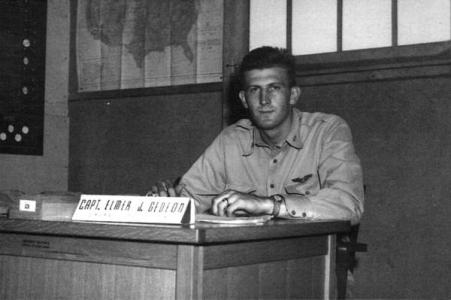
Elmer J Gedeon – nephew of former major league infielder Joe Gedeon, University of Michigan three-sport athlete and major league outfielder – was born in Cleveland, Ohio on April 15, 1917. He and cousin Bob used to ice skate together at Brookside Park in Cleveland. On one occasion the ice gave way and Bob plunged through. Elmer slid across the ice on his stomach and reached into the icy water to pull his cousin to safety. That’s the kind of person Gedeon was. “A very fine guy,” recalls Fred Janke, a University of Michigan football teammate. “A perfect guy. Everybody liked him.”
At 6-foot-4, he was a naturally gifted athlete and played baseball and football at Michigan, and is one of only two Major League Baseball players killed in action during World War II.
Gedeon received his summons for military service in January 1941. He went to spring training with Charlotte but joined the Army in March, taking induction at Fort Thomas, Kentucky. Gedeon reported to the Cavalry Replacement Center at Fort Riley on March 18, and was assigned to Troop B of the First Squadron, becoming an acting corporal the first day of the 13-week training program. Reno Simone, a young recruit who arrived at Fort Riley the same time as Gedeon, explains “I was assigned to the kitchens, and one morning Elmer showed up and said he was tired of his men being assigned kitchen detail so he put himself on KP.
Around Memorial Day, 1941, Gedeon transferred to the Army Air Corps. He earned his pilot’s wings and a commission as a second lieutenant at Williams Field near Phoenix in May 1942, and trained with the 21st Bomb Group at MacDill Field in Tampa.
Flight training was always a hazardous time and almost claimed the 25-year-old’s life on August 9, 1942. Gedeon was the navigator in a North American B-25 Mitchell medium-sized bomber that crashed on take off and burst into flames at Raleigh, North Carolina. Despite suffering three broken ribs, he managed to free himself and crawl from the wreckage, then realized a crewmate – Corporal Barrat was still inside. Without a moment’s hesitation, Gedeon went back inside the burning plane and pulled Barrat to safety. Gedeon was promoted to first lieutenant and awarded the Soldiers’ Medal for his heroics in a ceremony at MacDill Field.
In July 1943, Gedeon began training on Martin B-26 Marauders at Ardmore Army Air Field in Oklahoma. By the following month he was flying combat simulations and high altitude bombing practice in preparation for overseas duty with the 394th Bomb Group.
In February 1944, Captain Gedeon arrived at Boreham Airfield in England with the 586th Bomb Squadron of the 394th Bomb Group. “Gedeon was the Operations Officer for the 586th,” recalls James Taaffe, his co-pilot at the time. “He had a delightful sense of humor and was a super gentleman.”
On April 20, 1944, just five days after celebrating his 27th birthday, Gedeon piloted one of 30 Marauders that left Boreham to bomb German construction works at Bois d’Esquerdes. It was the group’s thirteenth mission. As they approached the target area, German anti-aircraft fire intensified and Gedeon’s bomber was severely hit by flak. “We got caught in searchlights and took a direct hit under the cockpit,” says Taaffe. “I watched Gedeon lean forward against the controls as the plane went into a nose dive and the cockpit filled with flames.”
Taaffe was the only crew member able to escape the flame-engulfed airplane. As he descended by parachute and captivity at the hands of the Germans, he watched the bomber smash into the ground, carrying Gedeon and five others to their death.
Gedeon was reported missing in action, and it was not until May 1945 that his father, Andrew A Gedeon, received word from his son’s commanding officer that Elmer’s grave had been located in a small British army cemetery in St Pol, France.
We honor you, Elmer Gedeon.
